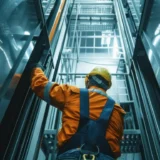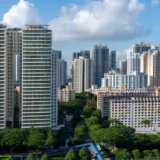New Altre Digital report reveals dramatic shift in leasing behavior across India’s top seven cities, with sustainability now driving office demand and investment
India’s commercial real estate market is undergoing a fundamental transformation. Green-certified buildings are no longer just a niche offering. They’re now commanding premium rentals of up to 50 percent, driven by growing ESG mandates from occupiers, investors, and developers.
This shift is detailed in a new report from Altre Digital, a technology-led commercial real estate consultancy. The firm analyzed more than 3,000 buildings and over 1 billion square feet of office space across India’s top seven cities. Their findings show a clear trend: sustainability is no longer a checkbox. It’s a business priority.
Green buildings earn up to 50 percent more in rentals
The report shows that conventional office buildings with green certifications are commanding 18 to 22 percent higher rents than their non-certified counterparts. But the biggest leap is seen in flexible workspaces. Green-certified flex spaces now earn rental premiums of 47 to 50 percent compared to standard offerings.
This pricing shift is not based on optics or trend-chasing. It reflects real performance, better tenant retention, improved building efficiency, and stronger long-term asset value.
“Commercial real estate is no longer being evaluated purely by location or amenities. Today, buildings are valued by what they conserve and enable energy, water, health, and resilience,” said Shweta Sawhney, Founder and CEO of Altre Digital.
India climbs global green rankings
ndia is rapidly gaining ground in global sustainability metrics. In 2024 alone, 370 new projects in India earned LEED certifications, covering more than 8.5 million gross square meters. This achievement placed India third in the world for green building certifications, surpassing Hong Kong and South Korea.
As of 2025, India’s total, green-certified office inventory has crossed 700 million square feet. LEED certifications account for 81 percent of that, followed by IGBC with 9 percent.
Bengaluru leads the way with a 30% share of this stock, followed by Mumbai at 15%, Hyderabad at 14%, and Pune at 12%. Gurugram contributes 11.5 %, while cities like Noida, Chennai, and New Delhi are catching up fast.

Some micro markets have already gone all in. Bengaluru’s Outer Ring Road, Cyber City in Gurugram, and Hyderabad’s IT Corridor have achieved over 90% green penetration, making them the most sustainable office hubs in the country.
Why sustainability now drives office leasing?
Despite the higher rents, green buildings are increasingly the first choice for multinationals, institutional investors, and flex workspace operators. The reasons go beyond compliance or branding.
Green-certified buildings typically deliver 30 to 50 percent savings on energy consumption. Maintenance and operating costs are also 20 percent lower, thanks to automated systems and efficient design.
From an ESG standpoint, certified buildings help corporates meet increasingly stringent global sustainability mandates. With more companies now required to report emissions and operational footprints, choosing a green office is a practical solution. Not just a feel-good move.
Tenant experience is another major driver. Certified buildings offer better indoor air quality, improved natural lighting, and thoughtful, wellness-oriented layouts. These elements contribute to employee satisfaction, reduced absenteeism, and better productivity.
Green-certified flex spaces are leading the charge
The biggest jump in rental premiums is seen in the flexible workspace segment. As hybrid and distributed work models become the norm, companies are actively seeking plug-and-play solutions that meet ESG expectations and offer agility.
In cities like Mumbai, Bengaluru, and Gurugram, green-certified flex spaces are commanding nearly 50 percent more rent than non-certified peers. Tech companies, global capability centers, and high-growth startups are leading this demand, valuing the combination of sustainability, flexibility, and operational efficiency.
Institutional capital is flowing into green assets
The report also highlights a growing trend among institutional investors who are prioritizing green-certified assets for long-term investments. With global capital increasingly moving toward sustainable and ESG-compliant projects, Indian developers are under mounting pressure to deliver buildings that meet these new expectations.
This shift is not limited to foreign capital. Domestic investors are also showing strong interest in green buildings, recognizing their value in future-proofing portfolios and reducing regulatory and reputational risks.
“In Q1 2025, 80 out of every 100 square feet leased in India’s top office markets was in green-certified buildings,” said Sawhney. “This is not just a sustainability story. It’s a performance story. The return on investment is real, measurable, and growing.”
Conclusion
India’s green building movement is no longer a trend. It’s now the foundation of a future-ready real estate strategy. From Bengaluru’s tech corridors to Mumbai’s central business districts, sustainable buildings are attracting the best tenants, the highest rentals, and the most capital.
With over 700 million square feet of certified green office space and growing demand from ESG-conscious businesses, India is well on its way to becoming a global leader in sustainable commercial real estate.
For businesses and property owners, the message is clear. Adapt to ESG or risk being left behind in an evolving marketplace.
If you’re looking to increase the value of your commercial property or align your workplace with the future of sustainable business, Nanya Services helps businesses transition to ESG-ready real estate solutions. From green audits to smart retrofitting, we work with you to future-proof your asset and unlock long-term value.
Frequently Asked Questions(FAQs):
Green-certified buildings offer better energy efficiency, lower operating costs, improved indoor air quality, and help companies meet ESG mandates. These benefits make them more attractive to tenants, leading to higher demand and up to 50% rental premiums.
Bengaluru leads with 30% of India’s total, green-certified office space, followed by Mumbai (15%), Hyderabad (14%), Pune (12%), and Gurugram (11.5%). Areas like Outer Ring Road (Bengaluru), Cyber City (Gurugram), and the IT Corridor (Hyderabad) have over 90% green building penetration.
Certified green buildings reduce energy and water consumption, cut carbon emissions, and promote employee well-being. These factors help companies comply with environmental and social governance (ESG) standards and reporting requirements.
The most widely recognized certifications are LEED (Leadership in Energy and Environmental Design) and IGBC (Indian Green Building Council). Together, they cover over 90% of certified green office spaces in India.
Yes. Older buildings can be upgraded with energy-efficient systems, sustainable materials, smart automation, and eco-friendly infrastructure. Firms like Nanya Services LLP offer green audits and retrofitting solutions to help commercial buildings meet ESG expectations and increase long-term value.



























